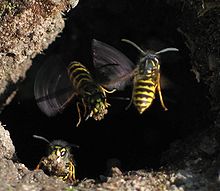Aculeata
| Aculeata Temporal range:
| |
|---|---|

| |
| Vespula vulgaris | |
| Scientific classification | |
| Domain: | Eukaryota |
| Kingdom: | Animalia |
| Phylum: | Arthropoda |
| Class: | Insecta |
| Order: | Hymenoptera |
| Suborder: | Apocrita |
| Infraorder: | Aculeata (but see text) |
| Superfamilies | |
Aculeata is a subclade of Hymenoptera containing ants, bees, and stinging wasps. The name is a reference to the defining feature of the group, which is the modification of the ovipositor into a stinger. However, many members of the group cannot sting, either retaining the ovipositor, or having lost it altogether. A large part of the clade is parasitic.
This group includes all of the eusocial Hymenopterans. It is theorized that the possession of a venomous sting was important in the repeated evolution of eusociality within Hymenoptera.
The oldest aculeates are known from the Late Jurassic Karabastau Formation of Kazakhstan, represented by the family Bethylonymidae, which may be para or polyphyletic.[1]
Classification
[edit]The use of the name Aculeata has a long history at the rank of infraorder or division. The Aculeata are a monophyletic, or good natural group, containing all the descendants of a single common ancestor. The Aculeata are therefore maintained as a taxon, either at infraorder or division rank or as an unranked clade.[2][3][4][5][6]
| Hymenoptera |
| ||||||||||||||||||||||||||||||||||||||||||||||||||||||||||||||||||
References
[edit]- ^ Grimaldi, David A.; Peñalver, Enrique; Barrón, Eduardo; Herhold, Hollister W.; Engel, Michael S. (2019-11-07). "Direct evidence for eudicot pollen-feeding in a Cretaceous stinging wasp (Angiospermae; Hymenoptera, Aculeata) preserved in Burmese amber". Communications Biology. 2 (1): 408. doi:10.1038/s42003-019-0652-7. ISSN 2399-3642. PMC 6838090. PMID 31728419.
- ^ Johnson, Brian R.; Borowiec, Marek L.; Chiu, Joanna C.; Lee, Ernest K.; Atallah, Joel; Ward, Philip S. (2013). "Phylogenomics resolves evolutionary relationships among ants, bees, and wasps". Current Biology. 23 (20): 1–5. doi:10.1016/j.cub.2013.08.050. PMID 24094856.
- ^ Branstetter, Michael G.; Danforth, Bryan N.; Pitts, James P.; Faircloth, Brant C.; Ward, Philip S.; Buffington, Matthew L.; Gates, Michael W.; Kula, Robert R.; Brady, Seán G. (2017). "Phylogenomic Insights into the Evolution of Stinging Wasps and the Origins of Ants and Bees". Current Biology. 27 (7): 1019–1025. doi:10.1016/j.cub.2017.03.027. PMID 28376325.
- ^ Schulmeister, S. (2003). "Simultaneous analysis of basal Hymenoptera (Insecta), introducing robust-choice sensitivity analysis". Biological Journal of the Linnean Society. 79 (2): 245–275. doi:10.1046/j.1095-8312.2003.00233.x.
- ^ Schulmeister, S. "Symphyta". Archived from the original on 21 June 2010. Retrieved 28 November 2016.
- ^ Peters, Ralph S.; Krogmann, Lars; Mayer, Christoph; Donath, Alexander; Gunkel, Simon; Meusemann, Karen; Kozlov, Alexey; Podsiadlowski, Lars; Petersen, Malte (2017). "Evolutionary History of the Hymenoptera". Current Biology. 27 (7): 1013–1018. doi:10.1016/j.cub.2017.01.027. hdl:2434/801122. PMID 28343967.
External links
[edit]- Tree of Life Web Project: Aculeata
- [1] Bugguide.net: Aculeata
- Johnson, B. et al. Phylogenomics resolves evolutionary relationships among ants, bees, and wasps. NCBI

